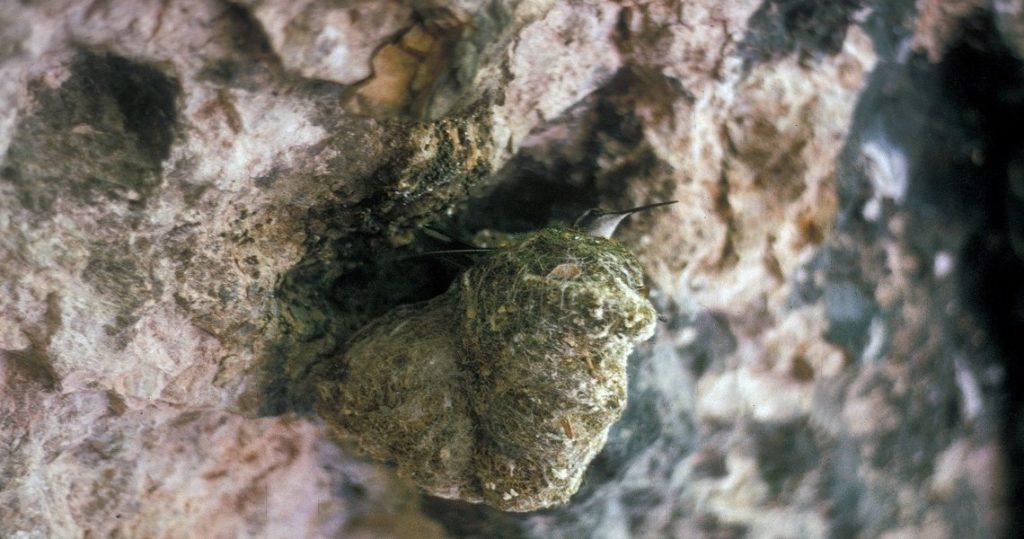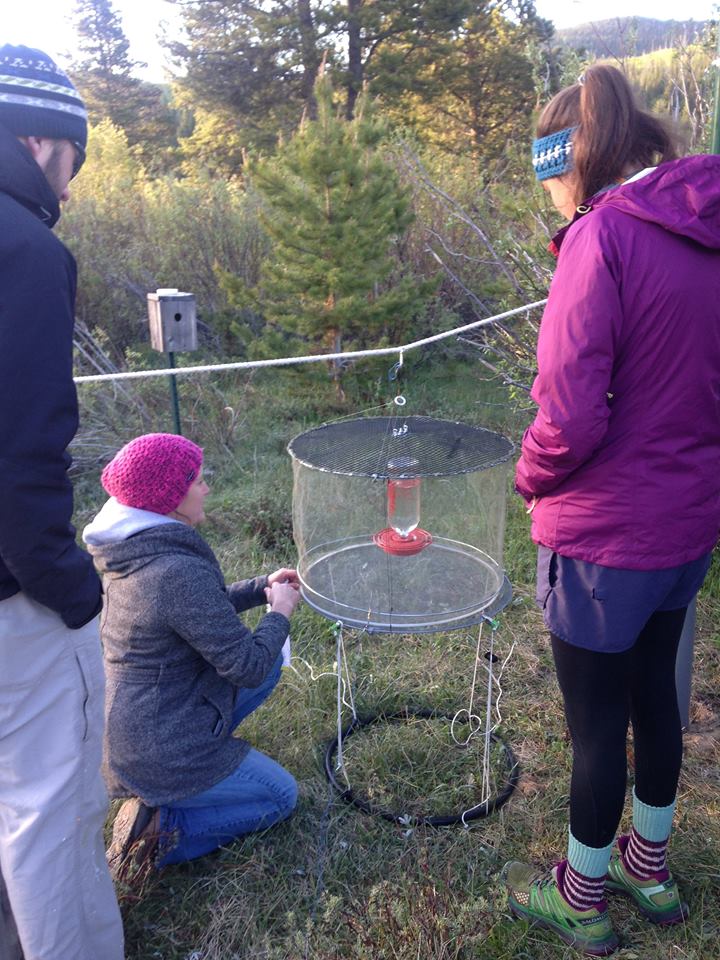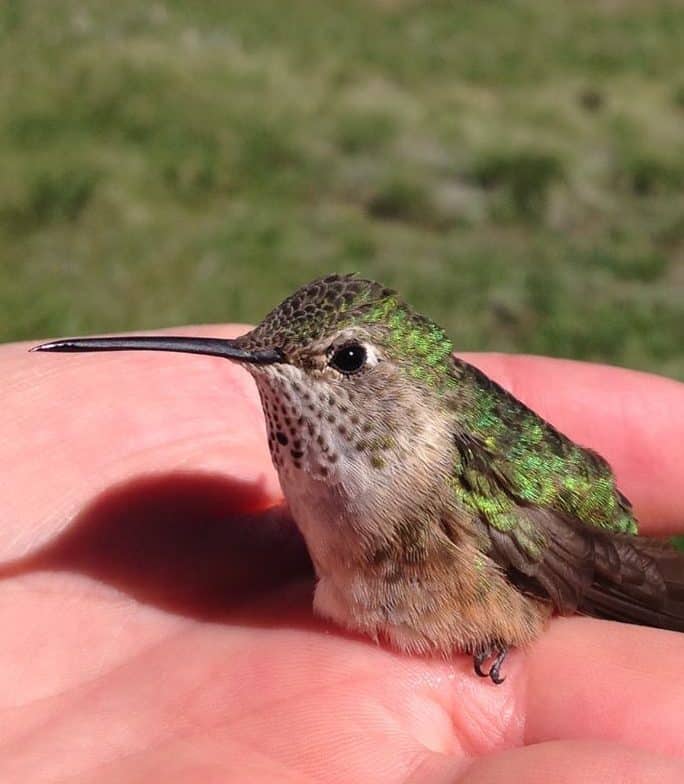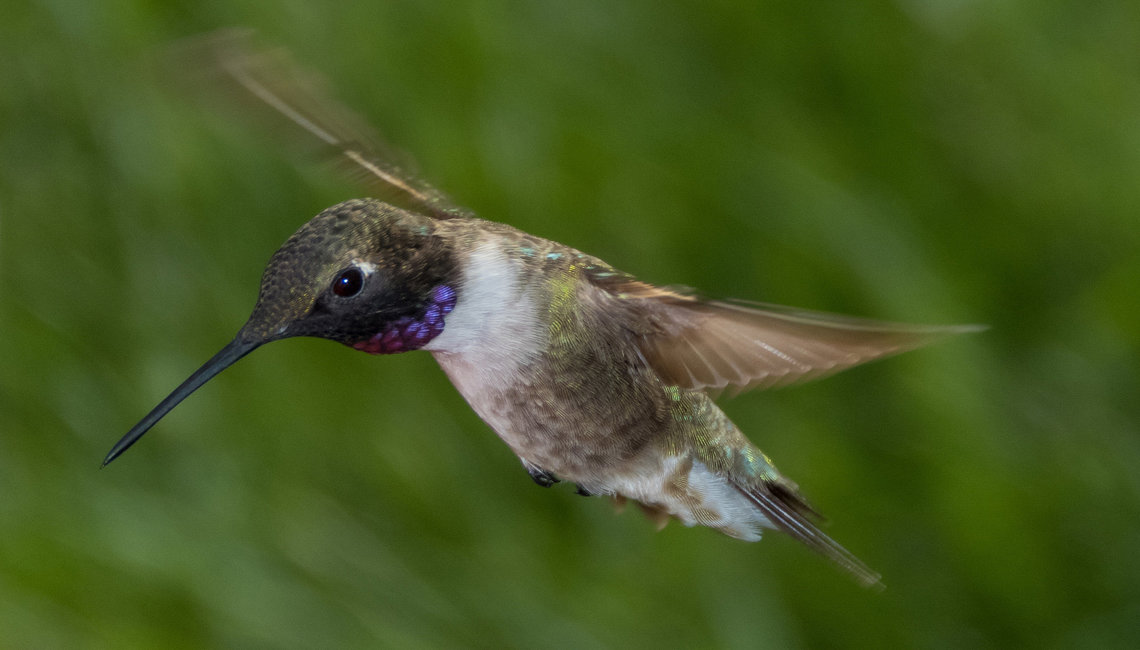By Susan Wethington, Executive Director, Hummingbird Monitoring Network
The Hummingbird Monitoring Network (HMN) is a non-profit organization that combines collaborative research, community involvement, and training to better understand and appreciate the importance of hummingbirds and their conservation in a changing climate. Every year, remarkable stories emerge as we continue our hummingbird conservation work. One of my favorites occurred this past summer when Branden, a University of Arizona undergraduate student interested in hummingbird conservation became an intern at American Museum of Natural History’s Southwestern Research Station. He learned of a 50-year-old photo of a Blue-throated Hummingbird nest found by hawk researchers, Helen and Noel Snyder, in a cave in the Chiricahua Mountains. With their directions, Branden found the cave and discovered that a Blue-throated female was still using the nest site. Incredible!

Because Blue-throated Hummingbirds live in wet riparian habitats, they will be one of the multitude of species adversely affected by current and predicted long-term drought conditions throughout western North America. Blue-throated Hummingbirds are pollinators, as are all hummingbirds. There is increasing evidence that pollination interactions are being disrupted by drought and climate change. This is likely the greatest threat to hummingbirds in North America. Through our coordinated monitoring network, researchers, students, interns and volunteers are investigating what hummingbirds need to survive, successfully reproduce, and maintain thriving populations. For the past few years, we have focused our collaborative work with Dr. Coro Arizmendi from the National Autonomous University of Mexico (UNAM). Through the HMN, monitoring efforts were carried out at multiple sites in Arizona, as well as at points across five states in Mexico. The research focused on detecting hummingbird responses to change, independent of the causes, which can be climate, environmental conditions, land use changes, restoration actions, and more.

Hummingbirds have high metabolic rates, good learning abilities, and quickly respond to changes in their habitat. Their quick responses are strongly influenced by complex mutualistic interactions with flowers. These cascading biological interactions help protect their nests from predators. Field counts, such as nest searches and hummingbird-floral point counts, more often reflect responses to current interactions and conditions rather than significant long-term responses.
To evaluate effectiveness of conservation actions, HMN is looking to its decade of coordinated monitoring data. HMN is detecting trends in hummingbird populations and identifying which environmental factors most affect their survival. The trend analysis suggests relatively stable populations for six species (Black-chinned, Broad-tailed, Rufous, Broad-billed, Rivoli’s, and Blue-throated Hummingbirds). However, capture-mark-recapture analyses that include environmental covariates find strong negative effects on survivorship. For example, increasing average maximum temperatures during the breeding season decreases survivorship for Black-chinned Hummingbirds. For Rufous Hummingbirds, decreasing minimum temperatures with increased precipitation has the strongest negative effect on their survivorship. In other words, cold wet breeding seasons are tough on Rufous.
Our recommendations for restoring hummingbird habitats are:
• Restore the nectar landscape to provide abundant, sequentially flowering nectar plants.
• Restore elements of vegetation structure typically found around hummingbird nest sites.
• Monitor hummingbird populations to detect their population responses to change.

The emerging Hummingbird Conservation Networks (HCNs) is an expansion of the HMN into programs that better represent our current work and vision. The HCNs include four key programs that will provide resources and opportunities for engaging partners in hummingbird and pollination services conservation. The HCNs programs are:
• Monitoring: Hummingbird Monitoring Network (HMN)
• Research: Hummingbird Field Study Institute (HFSI)
• Restoration: Hummingbird Conservation Communities and Reserves (HCCRs)
• Outreach: Hummingbird Conservation Learning Centers (HCLCs)
Progress has been made with the restoration half of HCN’s integrative project that seeks to engage communities to help fill gaps in the nectar landscape. Rocío Meneses is a past HMN intern, amazing nest searcher, and co-author of the book Los colibries de México: un viaje en su búsqueda. She is now a PhD student at UNAM, where she is continuing her work with hummingbird conservation. Rocío is working to help us develop programs that will engage communities in ways that they will benefit economically, socially, and ecologically from their hummingbird conservation actions.
We continue this year with clear directions and real hope that our work will make a difference for hummingbird conservation. To learn more about the HMN, or how to become involved, visit our website.

